Guest Column by Virginia Cooper.
Embarking on the journey to find a new primary care physician (PCP) can be challenging, particularly when your long-trusted doctor decides to retire. For many, this transition is not just about finding a new healthcare provider, but also about ensuring that their specific health needs, especially as minorities, are understood and respected.
The importance of finding a physician who not only has the skills but also the cultural competence to manage your health is paramount. This guide aims to streamline your transition to a new PCP, ensuring your healthcare needs continue to be comprehensively addressed, respecting both your health and cultural background.
Leverage Referrals from Your Retiring Doctor
When your trusted healthcare provider decides to retire, it’s an opportunity to benefit from their professional network. Your retiring doctor, familiar with your health history and needs, can provide targeted referrals to other healthcare professionals who share a similar commitment to patient care.
These referrals are often more than just names; they come with the retiring physician’s endorsement, providing you with a vetted starting point in your search. It’s an approach that not only saves time but also offers a sense of continuity in your healthcare journey.
Assess Online Patient Reviews
In today’s interconnected world, online reviews have become a crucial tool in evaluating potential healthcare providers. Platforms like Google, Healthgrades, and specialized healthcare forums are treasure troves of patient experiences and feedback. When sifting through these reviews, pay attention to comments about the doctor’s approach to patient care, their ability to listen, and their effectiveness in treatment. This insight is invaluable in gauging whether a potential PCP is not just competent but also the right fit for your unique healthcare needs. Be aware that some reviews may not be accurate or based on actual patient experiences.
Digitize Your Medical Records
In a world increasingly moving towards digital solutions, having your medical records in digital format is a significant advantage, especially to help with searching for documents. Saving documents as PDFs not only makes your personal health information readily accessible to you but also eases the process of sharing these details with a new healthcare provider.
Digital records allow your new primary care physician to quickly search and review your health history, allergies, past treatments, and medications, ensuring they can provide informed and personalized care from the start. Plus, you can change a file back to its original format easily if needed.
Opt for an In-Network Physician
Navigating the complexities of health insurance can be daunting. One practical step to ensure affordability in your healthcare is to select a PCP who is in-network with your insurance provider. This choice not only helps in maximizing the benefits you receive under your plan but also plays a crucial role in managing out-of-pocket costs. It’s a decision that balances financial prudence with access to quality healthcare.
Connect with Culturally Competent Physicians
For minority patients, the importance of finding a culturally competent physician cannot be overstated. Such physicians bring an understanding of the nuances of different cultures and how these can impact health and healthcare experiences. They are better equipped to provide care that is respectful of and tailored to your cultural background, leading to more effective and personalized healthcare outcomes.
Evaluate the Physician’s Location and Accessibility
When choosing a new PCP, practical considerations such as the location of their clinic, office hours, and the ease of scheduling appointments are important. A conveniently located clinic reduces the stress and time involved in accessing healthcare. Additionally, the AMA Ed Hub notes that flexible office hours that match your schedule can make a significant difference in maintaining regular health check-ups and treatments.
Explore Healthcare Coverage Options
For those who are freelancers or self-employed, traditional employer-based health insurance may not be an option. In such scenarios, Policygenius points out that exploring healthcare coverage through the Affordable Care Act (ACA) becomes essential. The ACA offers a range of plans that can provide comprehensive coverage, ensuring that you have access to quality healthcare regardless of your employment status. You can also consider Direct Primary Care and other cash-based practices.
The transition to a new primary care physician post the retirement of your current doctor can be seamless with the right approach. By seeking referrals, researching thoroughly, maintaining digital medical records, choosing in-network physicians, valuing cultural competence, considering logistical aspects, and exploring coverage options, you ensure a smooth transition. This proactive approach guarantees continuity in your healthcare journey, with your unique needs as a minority patient being met with empathy and expertise.
Read more informative articles on the Marilyn Singleton, MD JD blog today!
Bio
Virginia Cooper is a retired community college instructor. She always encouraged her students to see the real-world value in their education, and now, she wants to spread that message as wide as possible. Her hope is that Learn a Living (learnaliving.co) will be a go-to resource for adult learners embarking on starting, continuing, or finishing their education.







